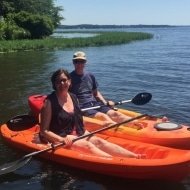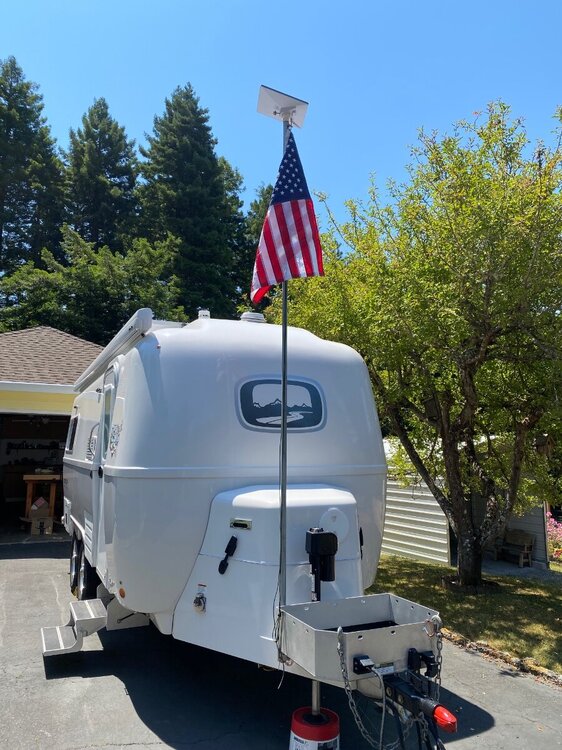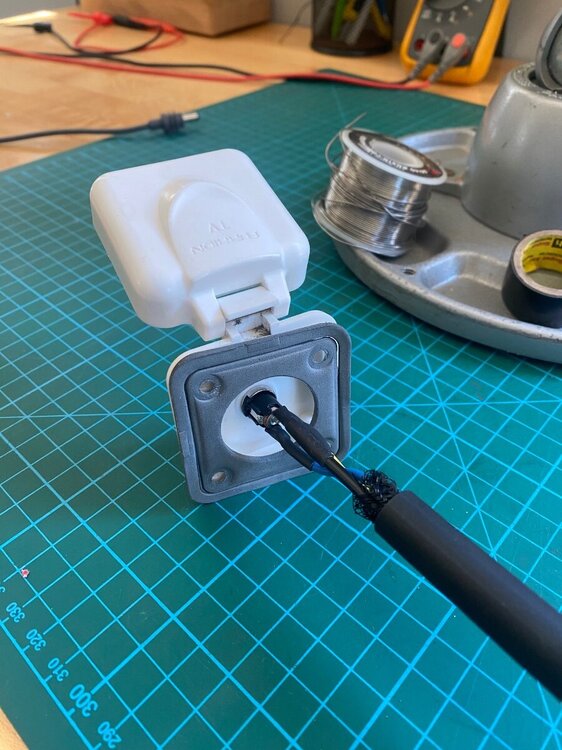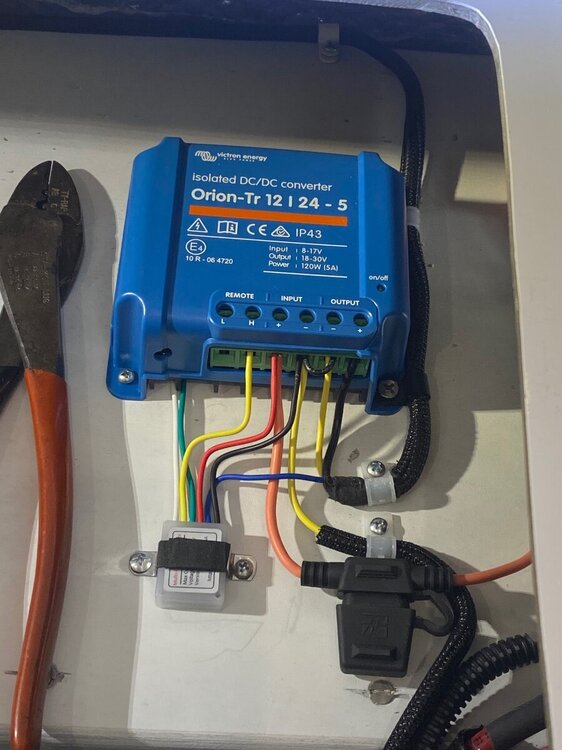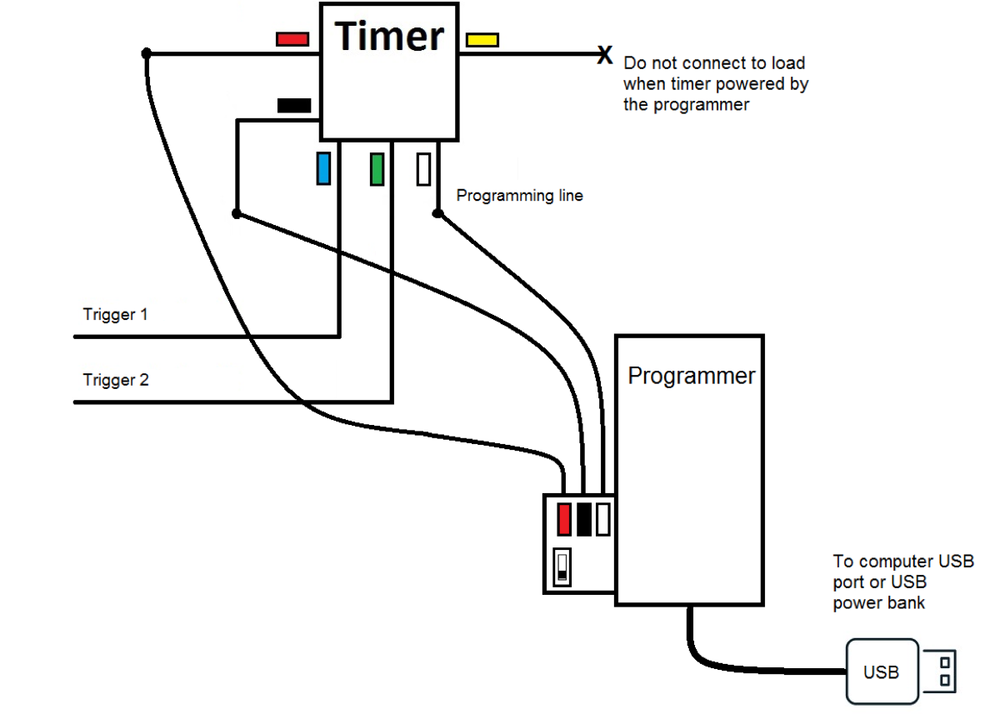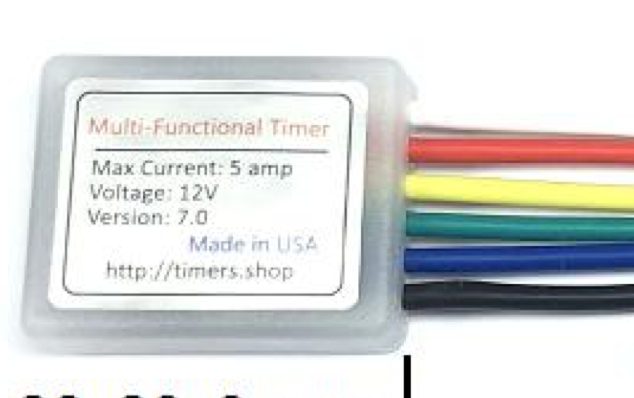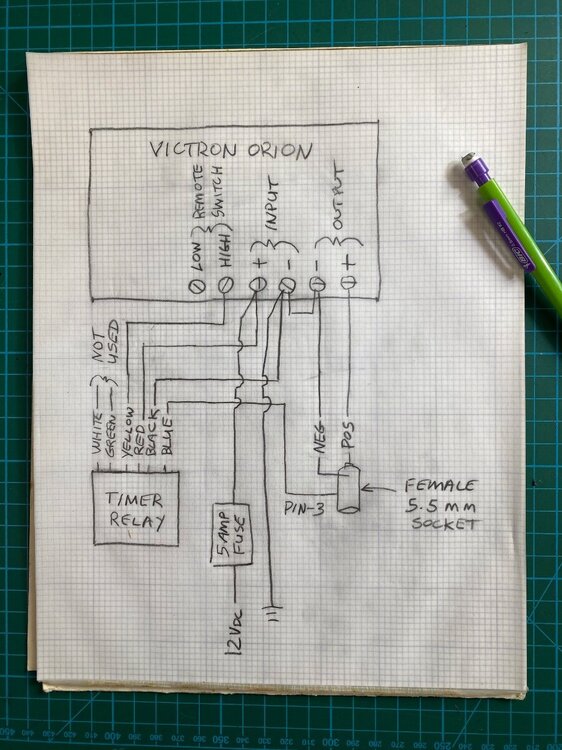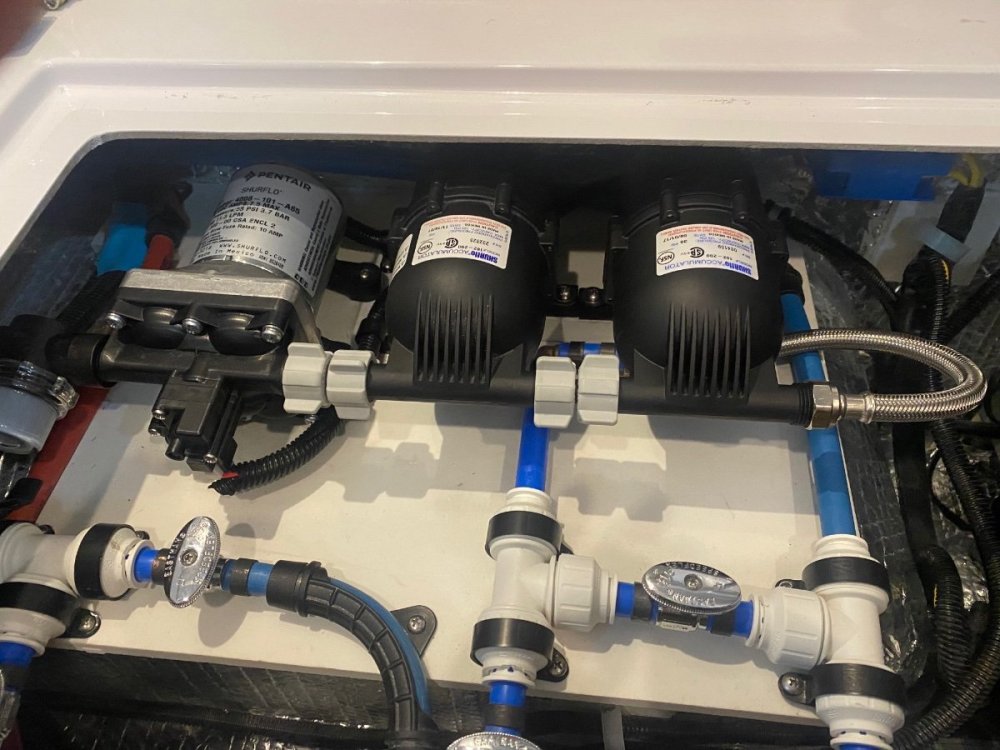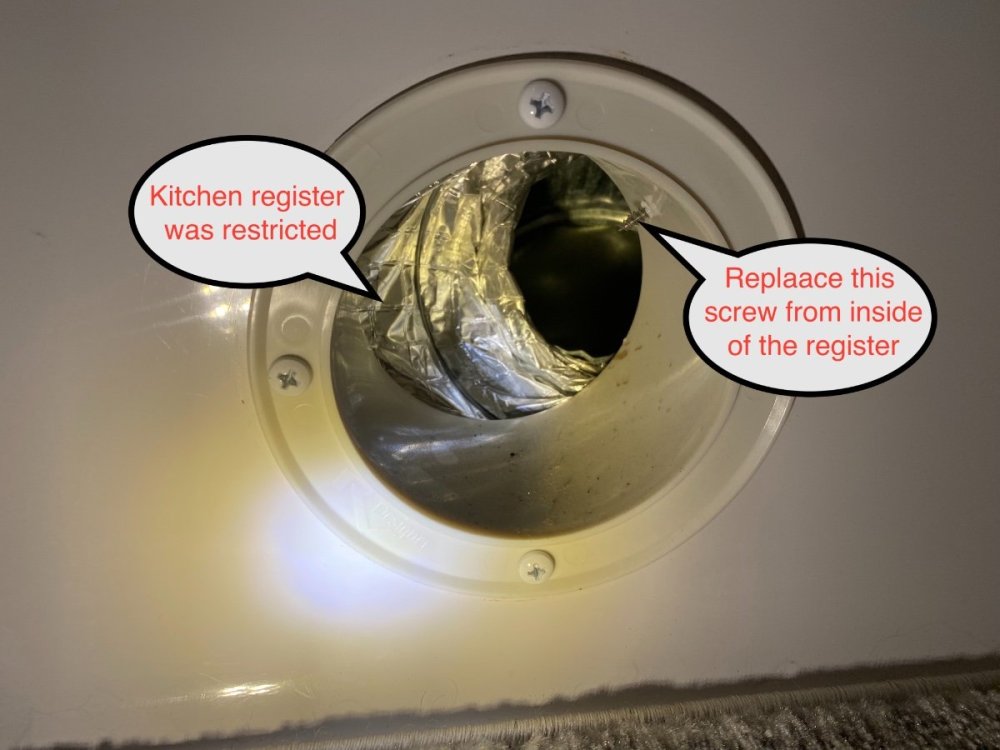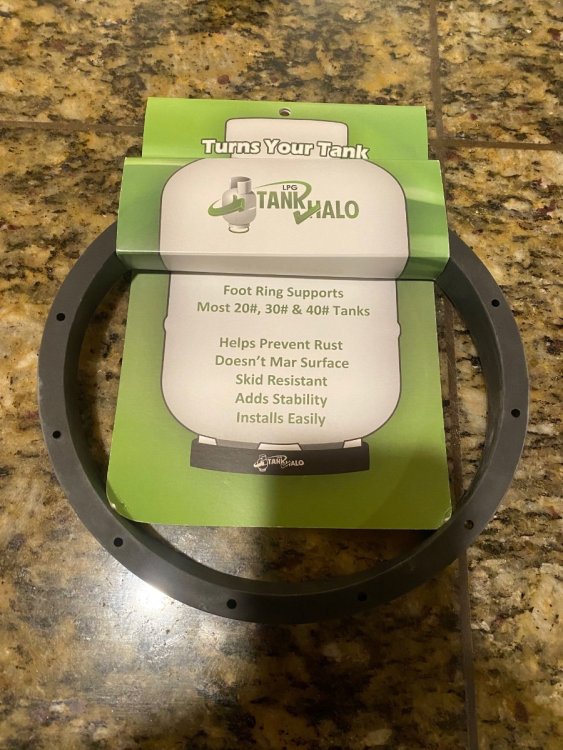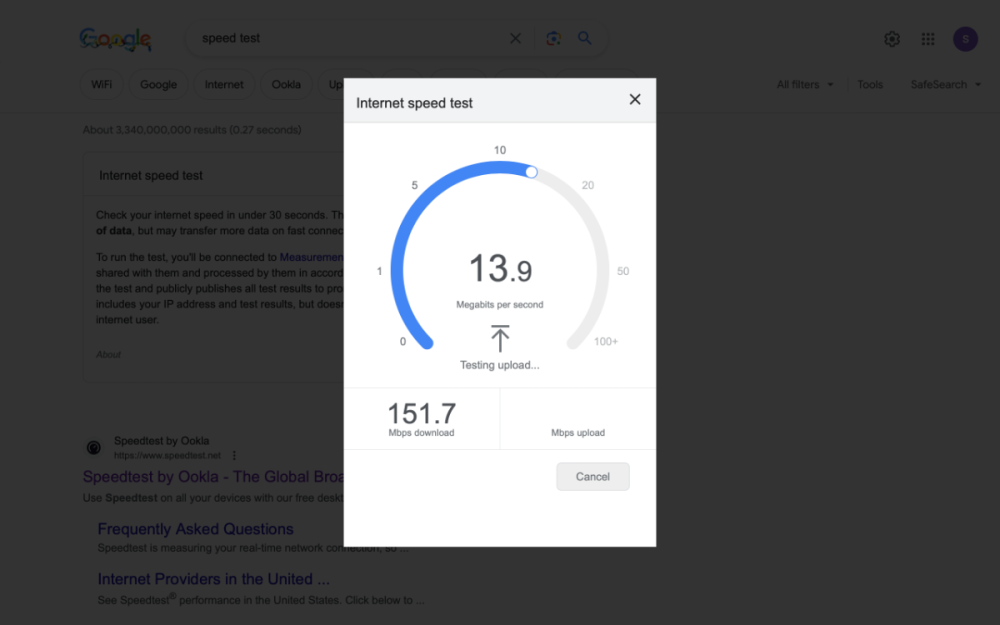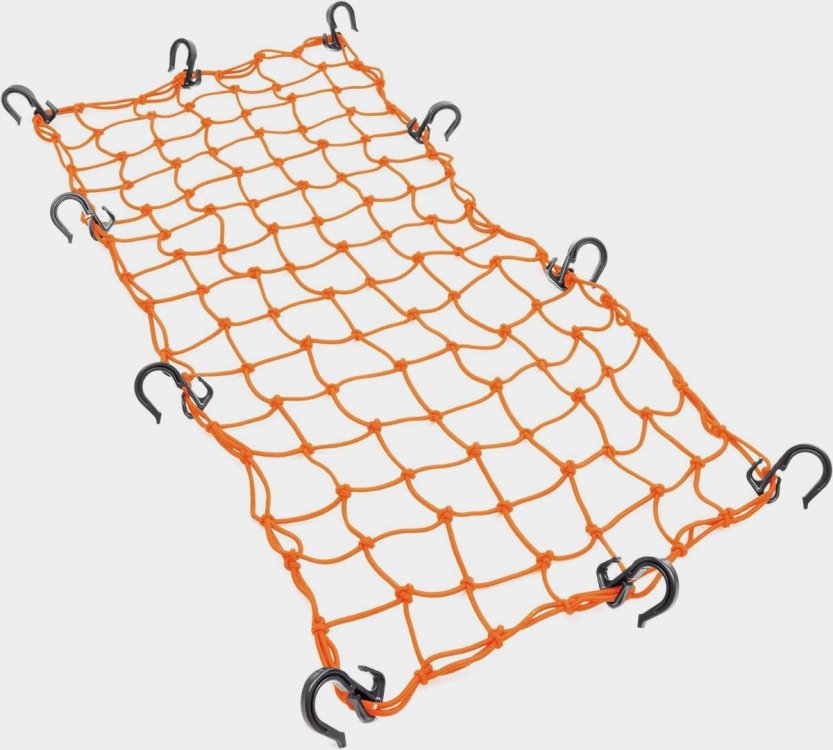
Snackchaser
Members-
Posts
20 -
Joined
-
Last visited
My Info
-
Gender or Couple
Couple
My RV or Travel Trailer
-
Do you own an Oliver Travel Trailer, other travel trailer or none?
I own an Oliver Travel Trailer
-
Hull #
1027
-
Year
2022
-
Make
Oliver
-
Model
Legacy Elite II
-
Floor Plan
Standard Floor Plan
Recent Profile Visitors
492 profile views
Snackchaser's Achievements
-
- 1 reply
-
- 2
-

-

-
After lugging around my old heavy Gen-1 Starlink for a few years, I was thrilled to get the new Starlink Mini. It’s small and light, and the router is built into the dishy. It speed tested at 202 Mbps, a very respectable speed, although not as fast as the Gen-3 which typically runs over 300 Mbps. The Mini comes with a 50’ x ~1/8” diameter power cord that has 5.5 mm barrel connectors on each end. It also comes with a 120 volt AC wall transformer that puts out 30 volts dc (vdc.) The Mini is rated to run on 12 to 48 volts vdc, and 25 to 40 watts. It peaks at 60 watts with snow melt on. The 12 Vdc rating is an attractive feature, particularly for Boondockers who don’t have inverters. However, when I first hooked it up to the Oliver’s 12 Vdc battery… it would’t work?? After some investigation, it turns out that it’s not so simple and I’ll try to explain why: Given that the AC transformer puts out 30 volts, and the power is about 40 watts, then it would be drawing 1.3 amps per Ohms law (40w/30v = 1.3 amps.) With the same calculation at 12 volts, the amperage increases to 3.3 amps. The resistance of the long thin power cord can’t handle this higher amperage and the resulting voltage drop puts it below the minimum 12 volts operating range. In fact, I did some bench testing and found it would only work at voltages over 18 volts. There are solutions to this issue including cutting the cable shorter, using a larger gauge cable, or increasing the voltage. Without a better option, I chose to increase the voltage. I looked at cheapie power converters that would probably work, but I wanted something more robust and higher quality. I found a Victron Orion TR 12/24-5, isolated, DC to DC Converter, and it was perfect for the job. It has a 12 Vdc (+/-) input and an adjustable output of 20 to 30 Vdc at 5 amps. Standby power is under 80 mA, and it has remote on/off switching capability. It comes factory set at 24 Vdc, but I adjusted it to 30 Vdc output with the potentiometer on the front. To connect the Mini to the trailer’s 12 Vdc power system, I installed a 5.5 mm female panel mount socket into the Satellite TV inlet. I removed the Coax connector and the 5.5 mm socket and nut fits perfectly in it’s place. Oliver conveniently labeled it “Satellite.” If you need the satellite TV, then install a third “Furrion” inlet as I did for my old starlink RJ45 connector. I mounted the Victron under the rear seat on the street side. The socket wiring was sheathed and routed along the ceiling of the outside storage garage. There are a number of options to pick-up 12 volts in that area, I took power off one of the circuit breakers. I ran the negative wire to the ground bus under the rear dinette seat. The Mini comes with both a snap-in kick-stand and a 2” pole mount, and they’re both necessary for optimum RV use. I prefer having it on a pole, but we often have to move the dishy away from the trailer for a clear sky view. That’s why it’s a bad idea to shorten the cord. It also has an RJ45 port that I suppose is for hardwiring without WIFI, but I probably won’t ever use that feature. I built-up some PVC fittings on my 10’ Electrical Metallic Tubing (EMT) mast to fit the Mini’s pole adapter. (See the post for Tacky Starlink Dishy Mast). A little sanding was involved, and the starlink mount uses a thumb screw to hold it in place. It’s better to turn the Victron off when not in use, so I recommend using the remote switching feature with a switch installed in an easily accessible location. I’m too forgetful to switch the Victron off every time, so I came up with a way to turn it on & off when the Mini’s power cord is plugged in & out. Read on if your interested in that part of the installation: The “three pin” 5.5 mm female socket sold by Amazon has a built-in switch that’s designed for appliances that use either batteries or a 120v transformer supply. When the transformer is plugged in, the pin-3 switch opens to disconnect the batteries. This is opposite of what’s needed for the Victron remote switch, but it can be used to trigger a digital relay and it’s actually easier than it sounds. Amazon carries fun little programable 5 &10 amp timer/relays for under $20. I already had the 10 amp version in the Oliver for a hot water recirculation pump timer, and it works great! The 5 amp is adequate for this application, and you will also need the $20 dollar re-usable Bluetooth programer. They use 50 μA of idle current, which is nothing, and they can be programed for delay-on, delay-off, flashers, dimmers, duck decoys, and more. But for our application, we’re just interested in the trigger functions, specifically the “ground-open” trigger. Before installation, the relay has to be programed from a smart phone or computer. It’ links by WiFi to flash the program into the relays memory. Use wire nuts to connect the timer and programer together, and power them from a USB port. Follow the well written and simple programing instructions using the settings shown in the screenshot below. The relay requires a timing function, so I arbitrarily used function #12, which is “delay-on.” I set it randomly to 1.5 seconds. The trigger is programed to use the “Trig Blue” set at #5, which corresponds to the blue wire used as a “grounded trigger.” The green wire trigger is disabled. My wiring sketch shows that the timer is powered with 12 volts from the Victron’s positive and negative inputs. The relay’s yellow output wire feeds the positive side of the Victron’s remote switch (the negative side is not connected). The Victron’s output feeds the 5.5 mm power socket, and the blue trigger wire goes to the 5.5mm socket’s pin-3. Use a continuity tester to identify pin-3, it’s normally shorted to the negative lead of the socket and it “opens” when the male connecter is plugged in. The socket barrel is negative, or ground, and the center pin is positive 12 vdc. There is one other step to make this work. This Victron model is “Isolated,” meaning that the input and output “negative” terminals are isolated from each other. It needs to be “non-isolated” because the timer is grounded to the Victron input, and the socket is grounded to the output, and the trigger needs continuity between the two. So remove the jumper wire that comes on the Victron’s remote switch, and use it to jump across the two negative terminals. Victron support confirmed that shorting the grounds is not a problem, it just un-isolates it. This works satisfyingly well! I checked out the power draw with the solar turned off, and while streaming a video. It was 2 amps, 27 watts (after subtracting the parasite load). That’s a huge improvement over my previous Starlink, and I don’t have to worry about running the inverter and draining down the batteries anymore. I hope someone finds this useful Cheers! Geoff
- 1 reply
-
- 6
-

-

-
Are two accumulators better than one?
Snackchaser replied to Snackchaser's topic in Ollie Modifications
I got some good comments whether the second accumulator should be in series or parallel, so before I changed the plumbing, I decided to call the Surflo customer service for their opinion. Their Technician provided a lot of great information, and he confirmed that a 2nd accumulator will provide more reserve water, and it doesn’t matter if it’s in series or parallel. More interestingly though, he was of belief that one 24 Oz accumulator would only provide 2 to 4 Oz of reserve water. That sort of answered another question of how much reserve water to expect, and I was happy to know that I was getting more than twice that much. The technician also recommended that I set the PSI at 2 lbs. less than the pump “turn-on” pressure. Without knowing exactly what that was, I did some experimentation with higher and lower pressures and found that 30 PSI provides the most reserve water, which was about 13 Oz between pump cycles. This is definitely a project where the juice may not be worth the squeeze for everyone. But for us, it was all about the noise. That water pump can wake the dead during a late night bathroom visit, or early morning tooth brushing, and any improvement was worth the small effort. One 24 Oz accumulator wasn’t adequate in this regard, and there’s just not enough room for any of the larger accumulators. In conclusion, I didn’t get the amount of reserve water I originally expected out of two 24 Oz accumulators, but the improvement was good enough to get a flush and brush without waking the dead. I’m a happy camper . . . already looking for the next project! Cheers, Geoff -
Our Oliver came with the Shurflo 24 Oz accumulator that provides a reserve of water so that the pump won’t cycle on when only a small amount of water is needed. But it never seemed to be quite enough water and the pump would cycle anyway. It stands to reason that adding a 2nd accumulator would provide twice as much water (48 Oz) before the pump cycled on. . . right? Being a sucker for projects, I added a 2nd accumulator and there didn’t seem to be any improvement. In fact, I was surprised to find that there was only 12 Oz of water in reserve between pump cycles. That was strange, so I removed the second accumulator and tested the original accumulator by itself. It was only getting 8 Oz of water between pump cycles. What the heck? Shouldn’t it be closer to 24 Oz as the accumulators rating implies? I verified both accumulators had a 30 PSI pre-charge as recommended, and my system seems to have good pressure. I’ve ordered a water pressure gauge, but I’ve no clue what the accumulator PSI should be in relationship to water pressure. I’m hoping that the greater wisdom of this forum can provide some insight on this. Cheers, Geoff
-
FYI On my LEII there is an underfloor pass through from street side to curb side just aft of the fresh water tank, and forward of the rear jacks. Plenty of air can pass though there.
-
Does anyone happen to have a picture of a return air vent in the bathroom? Is there is a corresponding vent under the dinette seat, or does it return the air through the underbelly? I'm unclear if this was something that Oliver was now doing, and/or, if it's only for Truma units? Adding a return vent in the bathroom seems like a worthwhile modification, although it also seems like it could create a draft when the heat is not on.
-
I just completed installation of a Victron Smart Orion 30 amp isolated DC to DC charger after reading all the great information provided in this forum by MAX Burner, and others. I really appreciated all their groundwork and details, so I wanted to share some of my experiences in the hope that others will find it useful. I used #4 AWG wire for ease of installation and for better termination options. BatteryCablesUSA recommended their “Jumper Cable” wire and it was the best deal I found at $197 for 55’ x 2. It consists of a black and red cable joined together like zip cord, and it’s flexible enough to lay flat under it’s own weight. Their lugs and heat shrink were also reasonably priced. I sheathed the full length of the cable with 3/4” braided cable sheath for extra protection and good looks (Amazon Keko 100’ roll for $21.) I seized the ends with Amazon XFasten fabric Wire Harness Tape (5 rolls for $14.) BatteryCablesUSA also recommended Anderson SB50 connectors, instead of the larger #4 AWG rated SB120 connectors that I originally planned. They said that #4 AWG wire would fit in the SB50 #6 AWG contact pins, which it did. I used Trailer Vision covers for the Anderson SB50 connectors. A TV-201426-50 surface mount receptacle with hinged cover plate was installed under the truck bumper. It has a red LED power indicator that I discourage from connecting because it’s on all the time and annoyingly bright. They also offer a flush panel style mounting. The sheathed cord on the trailer side got the Trailer Vision TV-328993-50 plug cover. It has a protrusion that catches on the mating receptacle’s hinged cover to stop it from pulling out. It’s similar to how the 7-pin connector ports hold the plug in. It also has a LED power indicator that’s more useful because it’s only on when connected. It uses a compression gland for the cable that I filled with black RTV. Powerwerx company sells Trailer Vision parts, Anderson connectors, and other accessories for reasonable prices. Get at least 4 extra #6 Anderson pins for connecting to the Victron compression terminals as explained later. Powerwerx also sells the “PanelpodSB,” which is a surface panel mount Anderson SB50 housing for $11.99. I mounted one on the Oliver’s cargo box for “parking” the Anderson connector when it’s not plugged into the truck. It keeps with my existing theme of parking places for the 7-pin cable and RAM rear view camera cable. They also sell a tethered cap to keep it clean when traveling. The engine compartment wiring was straight forward. I connected the cable’s red wire to a 60 amp terminal post fuse on the battery positive. The black wire terminated to the battery negative. The trailer half of the sheathed cable went through a penetration behind the LP tanks. A hole was drilled through the trailer wall next to the existing penetrations with a 1-1/8” step bit. The sheathed cable passed though an Amazon PA66 1” nylon cable gland ($7.99 for two.) I used a short piece of heat shrink over the sheathing where it passed through the gland and filled the gaps with black RTV. The shelf under the bathroom sink has to be removed for access to the inside cable penetrations. From there the cable can be simply pushed under the floor to the rear dinette seat where the Victron was mounted. The Victron has some great safety features that will automatically reduce, or shutdown, the output if it gets too hot or the input voltage drops too low. It’s important to take this into consideration because it would likely happen while driving, and you wouldn’t know it without constant monitoring. Voltage drop especially comes into play with the new smart alternators that lower voltage output to save energy. The Victron’s default voltage settings account for this. However, due to the longer run of cable needed with travel trailer installations, the cable resistance can cause enough voltage drop where it can go below the default settings and cause the Victron to derate it’s output. I calculated the voltage drop for different wire gauges at 35 amps (nominal input current) and a cable distance of 53’ x 2. The results don’t include the connector and termination losses: 1.46 volt drop for #6 AWG 0.92 volt drop for #4 AWG 0.58 volt drop for #2 AWG Per Victron’s instructions, a 0.6 voltage drop can cause a “Voltage Lockout” with the default settings. There are many factors that can affect this, and fortunately the Victron defaults can be adjusted. To account for my voltage drop, I decreased the “Start Voltage” from 14 to 13 volts, and the “Shutdown Voltage” from 13.1 to 12.8 volts. These setting were recommended by “Offgrid Power Solutions,” on a You Tube video called “Victron Orion-Tr Smart DC-DC Charger settings.” Cooling is also an important consideration for the Victron because they create a lot of heat, and they derate charging current 3% for every degree above 1040 F. That’s almost 50% performance loss at only 1200. Maximum operating temperature is 1310, where I believe it shuts down completely. This is why I installed cooling fans (but also for the fun of it.) Amazon’s ”Sound Original” low profile blower fans (two for $9.99) were the right size, they had bearings, brushless motors, and a good mounting configuration for this application. The Victron was mounted on 1/4” standoffs to keep its cooling fins off the mounting surface, and it also helps the fans to distribute air more evenly. I used a Normally Open, 1040, 5 amp, thermostat switch to control the fans (Amazon Uxcell KSD9700 (2 for $5.49). The fans get power from the input terminals on the Victron so they can only come on if the truck is connected, and the temperature is over 1040. The thermostat switch resets at 860. The Victron was mounted on a painted plywood board that was attached to the forward battery compartment wall. It’s an easy to reach, out of the way location. I used 4 rubber well nuts that stay in place by themselves, but regular nuts and bolts could be used. The sheathed #4 cable was terminated to the Victron’s input compression terminals, with the fans power leads. I struggled at first with the Victron’s compression terminations, the wire wouldn’t fit, and I couldn’t find #4 square ferrels. So I was pretty pleased to discover that Anderson pins can be filed down to fit perfectly. Just be sure to cover the exposed barrels with heat shrink. The negative output of the Victron went to the main chassis ground post under the rear dinette seat where there is a 2/0 cable going directly to the battery negative. The positive output was connected to the line side of a Blue Seas 60 amp fuse block, from there it went to the line side of the existing inverter’s DC circuit breaker, which is jumpered to the battery positive with a 2/0 cable. With the TV at idle and the lithium batteries around 60%, the Victron output was 35.8 amps as measured by a clamp-on amp meter. The TV input was 42.5 amps. This calculated to 84% efficiency, which is close to Victron’s 87% claim, which I assume is under perfect conditions. I really liked the looks of the sheathed cable and Trailer Vision plug and receptacle,. The hinged receptacle cover will keep the dirt out when not towing. The plug and receptacle are locked together more securely with the Trailer Vision covers, otherwise the Anderson connectors can be fairly easily pulled apart and they might not stay together on a bumpy road. Cheers, Geoff
- 2 replies
-
- 12
-

-

-
Nice mod! Looks factory👍
-
We also use a hitch lock as seen in MAX Burners photo above. Proven Industries sells them without the locking Puc so that you can use the Paclock brand Puc. Paclock gets top reviews by You Tube's LockPickingLawyer who makes his living demonstrating how quickly and easily most locks can be picked. Paclock makes all sorts of locks, and you can get them all keyed alike. We carry only one key that fits the hitch lock, bike locks, and other locks around the property. Cheers, Geoff
-
Bathroom Heat - a more direct approach!
Snackchaser replied to Snackchaser's topic in Ollie Modifications
Yes, it's directly attached to the Tee for the kitchen register. The 3" duct goes on to the bathroom through some sort of firewall and it's not easily reached. There was enough slack in the 3" duct to pull the Tee (with attached reducer) out through the access port that's under the forward kitchen drawers. The space is tight, and you will need to detach the 4" side from the furnace to get enough slack on that side. You can make most of the new connections while it's out. You'll need to disconnect the kitchen register first. The screw holding the duct to the register can be reached through the access port, but it's easier to replace it from the inside of the register, rather than trying to do it blindly from inside the access port. Cheers, Geoff Here's a photo that I forgot to add in the original post: -
Like others, we’ve been disappointed with the lack heating in the bathroom. In our Oliver, even the kitchen had minimal air flow and hot air was blasting under the bed. When I took a closer look at the duct routing from the furnace, the problems became obvious. There were two 4” ducts coming out of the furnace, one from the front outlet facing towards the registers, and the other from the rear outlet facing away from the registers. The front outlet was connected to the bedroom register with one 900 bend. It had the shortest run with the least turns, and twice as much air flow as the other two combined. The rear furnace outlet was connected to the kitchen register after making a 1800 u-turn. From there it was Tee’d and reduced to 3” to feed the bathroom. The 3” duct then takes a long and torturous path to reach the bathroom. The resistance from over 2800 of turns, and the longer run, resulted in much lower air flow to both the kitchen and the bathroom. I also found a hole from where the duct had been rubbing on the hot water valve, and the kitchen had a restrictively tight bend at the register. Fortunately this was a relatively easy fix, and the results were significant. Our 2022 Elite II has the Dometic furnace, but I suspect that other furnace brands could have similar ducting issues and it might be worth taking a look. The sketch shows how the duct routing was modified for better balance to all three registers. The bedroom and kitchen registers now feed from the high resistance u-turn at the rear furnace outlet. The bathroom has its own feed from the front outlet giving it the minimal number of turns possible. This modification involved moving the Tee which is under the kitchen cabinet. There is an access port under the forward kitchen drawers to reach the Tee and kitchen register, and it’s best to pull them right out of the access port to work on them. The 3” bathroom reducer stays in place and it gets a new duct directly to the front furnace outlet. The bedroom/kitchen gets connected to the rear furnace outlet. Rather than using flexible duct to make the 1800 u-turn, I used two 900 rigid fittings for less flow resistance. All of the parts needed for this modification are readily available at hardware stores. They usually sell duct by the foot, I bought 5’. Use sheet metal screws and foil duct tape for the connections to make sure they don't come apart. The kitchen register can be screwed together from the inside of the register rather than trying to do it from under the cabinet. I used an anemometer before and after the modification to measure flow, and a on-line calculator was used to get Cubic Feet per Minute (CFM): Before After Bedroom - 4” 100.7 53.2 Kitchen - 4" 39.3 65 Bathroom - 3" 11.8 30.2 Total 151.8 148.5 Cheers, Geoff
- 16 replies
-
- 22
-

-

-
I couldn’t find anything about this on the forum, and so I think it’s worth mentioning. We like doing dishes outside with hot water from the outdoor shower hose. We have a fold-up table dedicated for this purpose, but the shower hose was always just a little too short. I had a similar flexible hose in my junk stash so I added it to the Oliver hose with a 1/2” PVC nipple. It worked great, and there is no problem stuffing the extra length back into the Oliver shower port. Amazon carries various hoses that will work, including a 90” extension for under $15. Cheers, Geoff
-
I pulled my propane tank out and was horrified at all the rust around the bottom ring of the tanks, and on the mounting tray. That area seems to attract dirt and it eventually wore away the paint and rusted. Sand paper and paint fixed the immediate problem, but I wanted to prevent it from happening again. I started looking for some sheet rubber on Amazon, but then I discovered inexpensive rubber rings by Mopeka Products for$ 7.99. They are designed to fit on the bottom ring of the propane tanks. They fit perfectly, and they also stop that cringe worthy grind when putting the tanks on pavement.
- 11 replies
-
- 12
-

-

-
The new Starlink Gen-3 system is out, and it works great! I got one early because Starlink did a special invitation for Gen-1 users only, but now they are available for mobile accounts too. So here are my thoughts on some of the great new features and disappointments that are important for mobile users: 1. Gen-3 uses RJ45 connectors, and it works perfect with the Oliver installation described in my “Don’t cut your Starlink Cable” post. I had previously, and incorrectly, assumed that all Starlink’s systems used RJ45 connectors because thats what my Gen-1 dishy and Gen-3 router had. But alas, the far more common Gen-2 systems did not. Hmmm… that explains why Gen-2 users can’t use the upgraded Gen-3 routers. 2. The Gen-3 dishy is bigger than Gen-2 and it has a wider sky view. I’m not going back on the roof to measure it, but the shipping box is 25 x 15.5 x 3.75 inches to give an idea of the size. I’ve heard complaints that it’s bigger and harder to stow when traveling. In my opinion it’s way easier to stow because It has a convenient fold-up kickstand that eliminates the bulky tripod that came with older dishy’s. I really hated that tripod, it took up as much room as my BBQ. 3. The Gen-3 dishy has no motors or other moving parts, which should be more robust for the rigors of mobile use. 4. The Gen-3 power consumption is 195 watts per the label. That’s higher than Gen-1 (185w) and Gen-2 (about 65w.) This is not great news for boondockers. 5. Starlink still doesn't have a DC power option as many hoped. It has a separate 110v AC power supply with a 57vdc output (3.42amp) and a standard DC power connector. I’m sure someone will soon come up with a 12 to 57vdc volt power supply that can handle that wattage. 6. The Gen-3 router has longer WiFi range and it supports Mesh Node. Of course, the farther away from the router you get, the weaker the WiFi signal gets, and slower the internet speed gets. The Gen-3 router really helps with that. I’ve had a Gen-3 router on my Gen-1 dishy for a few months now and it made a huge difference in internet speed throughout the house. The Mesh feature allows you to add Nodes, sort of like radio relays, that give even further WiFi range, which is a good way to make new friends at camp. 7. The Gen-3 dishy comes with a built-in fold down kick stand designed to sit on a level surface. A pole mount option can be bought separately. You have to use the Starlink App during set-up to get it manually pointed in the right direction. I put mine on the peak of my roof facing West, and tilted it on the sloped roof to approximately match what the kickstand tilt would be if placed on a flat surface. The Starlink App liked the direction it was pointed, but it made me adjust the tilt a few degrees upwards before it would connect to the satellites. I don’t know if there is a work-around for that, but it might be a concern for fixed flat surface mounting such as an RV roof, and for the direction the vehicle is facing. From my almost 3 years of RV experience with Starlink, a fixed dishy mounting is not ideal. You need the flexibility to move the dishy around to find a clear sky view, so its going to be sitting on the ground a lot of time if you want to get a satellite signal. In conclusion, with its wider sky view, built-in kickstand, and the ability to lengthen the cable with a store bought RJ45 cable, I like the Gen-3 despite it’s short comings.
- 2 replies
-
- 10
-

-

-
I hadn’t seen any posts about this, so I thought I’d share this perfect little Amazon bungee cargo net: Powertye 15in x 30in Elastic Cargo Net with10 Adjustable Hooks and Tight 2in x 2in Mesh, $17.99 I originally bought it to carry firewood, and it can cover wood stacked higher than the bin if aluminum carabiners are used to make it a bit larger. Otherwise it holds a Costco storage bin just perfectly. Cheers, Geoff and Tanya
- 1 reply
-
- 5
-

-


